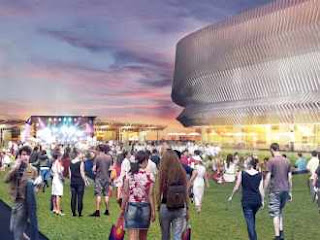Bruce Ratner expects the entire renovation will cost an estimated $229 million, but will require no public funding. The rent from the arena, along with ticket sales and other deals, will generate roughly $195 million over the period of its 34-year lease. Madison Square Garden, however, projected that they would raise $112 million within the same time frame.
The proposal calls for slashing 5,000 seats from the arena and for a new undulating facade designed to emulate the landscape of Long Island, with visual references to the dunes, beach fencing and boardwalks.
Ratner also plans to add a new plaza, theaters, restaurants, and bowling alley, and outdoor concert venue to the 77-acre site.
The Barclays Center team has a 34-year lease on the property now, with a 15-year option to renew. Over the initial term, the county would receive $195 million in revenue, coming from a mix of rents, ticket sales and other agreements, which could rise to as much as $335 million if Barclays exercises its right to the full 49-year term. The minimum annual payment would by $4 million per year, increasing by 10% every five years. MSG offered only a 5% increase each year, for a total of $112 million the first 34 years.
The Barclays Center bid has promised a $229 million project designed by SHoP Architects that sheathes the arena in a nest of glass and steel, looking like a hypertrophied Barclays Center. The remade arena would host 309 events a year, including boxing matches, college hoops, even six games by the Islanders hockey team, which are poised to move to the Barclays Center as soon as the 2013-2014 hockey season. Concerts will be led by the Barclays partners in the bid, Live Nation and Jay Z's Roc Nation.
Local developer Edward Blumenfeld, who was one of the four original bidders for the arena, will help develop a number of restaurant and retail outlets around the arena, which will be co-managed by Barclays and Legends Hospitality, which runs concessions at Yankee Stadium and the under-construction observation deck at the World Trade Center.
The project has been seen as a boon for Long Island, even though it has lost its beloved hockey team to Brooklyn in the process.
Following the announcement of the move last fall, Forest City Ratner offered to undertake a feasibility study of what to do with the Coliseum and the 63 acres of parking lots and empty land surrounding it.
The decision was made that the best use would be keeping an entertainment venue, even without a National Hockey League team, as an anchor for the local economy.
The most enticing piece of the plan is that, for taxpayers, it is free, as the bidders all agreed to finance the project themselves. This is contrary to two proposals made in the past decade, which sought nearly half-a-billion dollars in taxpayer financing. That most recent bid was scuttled in August 2011
Page Views
Since October 1, 2011



No comments:
Post a Comment